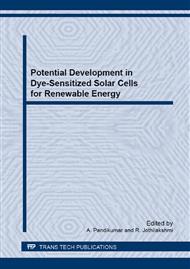[1]
B. Heinemann, Stoneham, M. Achusetts, Physics of polymer surfaces and interfaces, Isaac Sanchez (Eds.), the University of Michigan, 1992, p.336.
Google Scholar
[2]
D.L. Allara, S.V. Atre, A.N. Parikh, Polymer surfaces and interfaces II, edited by W.J. Feast, H.S. Munrom, and R.W. Richards (Eds.), John Wiley & Sons, Chichester, 27, 1993, p.314.
Google Scholar
[3]
H. M. Zidan, M. Abu-Elnader, Structural and optical properties of pure PMMA and metal chloride-doped PMMA films, Physica B 355 (2005) 308-317.
DOI: 10.1016/j.physb.2004.11.023
Google Scholar
[4]
T. Podgrabinski, E. Hrabovska, V. Svarcik, Characterization of polystyrene and doped polymethylmethacrylate thin layers, J. Mater. Sci.: Mater. In Elec. 16 (2005) 761-765.
DOI: 10.1007/s10854-005-4980-7
Google Scholar
[5]
P. Liu, Facile preparation of monodispersed core/shell zinc oxide@polystyrene (ZnO@PS) nanoparticles via soapless seeded microemulsion polymerization, Colloids Surfaces A, 291 (2006) 155-161.
DOI: 10.1016/j.colsurfa.2006.05.007
Google Scholar
[6]
N. Nakayama, T. Hayashi, Preparation and characterization of TiO2 and polymer nanocomposite films with high refractive index, J. Appl. Polym. Sci. 105 (2007) 3662- 3672.
DOI: 10.1002/app.26451
Google Scholar
[7]
T. J. Dawidczyk, M. D. Walton, W. S. Jang, J. C. Grunlan, Layer-by-layer assembly of UV-resistant poly(3,4-ethylenedioxythiophene) thin films, Langmuir 24 (2008) 8314-8318.
DOI: 10.1021/la800967x
Google Scholar
[8]
T. Kyprianidou Leodidou, P. Margraf, W. Caseri, U. W. Suter, P., Walther, Polymer sheets with a thin nanocomposite layer acting as a UV filter, Polym. Adv. Technol. 8 (1997) 505-512.
DOI: 10.1002/(sici)1099-1581(199708)8:8<505::aid-pat678>3.0.co;2-u
Google Scholar
[8]
C. L. Lu, J. F. Gao, Y. Q. Fu, Y. Y. Du, Y. L. Shi, Z. M. Su, A Ligand Exchange Route to Highly Luminescent Surface-Functionalized ZnS Nanoparticles and Their Transparent Polymer Nanocomposites, Adv. Funct. Mater. 18 (2008) 3070-3079.
DOI: 10.1002/adfm.200800452
Google Scholar
[10]
A. R. Gandhe, J. B. Fernandes, Methylation of phenol over Degussa P25 TiO2, J. Mol. Catal. A : Chem. 226 (2005) 171.
DOI: 10.1016/j.molcata.2004.10.035
Google Scholar
[11]
Krishnan, N. Venugopalan Pillai, V. P. Mahadevan. Pillai, R. Philip, Effect of cadmium oxide incorporation on the microstructural and optical properties of pulsed laser deposited nanostructured zinc oxide thin films, Mater. Chem. Phys, 121 (2010) 406-413.
DOI: 10.1016/j.matchemphys.2010.01.004
Google Scholar
[12]
V. P. Shantarovich, On the role of free volume in pick-off annihilation and positronium chemical reactions. J. Radiational. Nucl. Chem. 210 (1996) 357-369.
DOI: 10.1007/bf02056378
Google Scholar
[13]
S. Tao, Positronium annihilation in molecular substances, J. Chem. Phys, 56 (1972) 5499-5510.
Google Scholar


